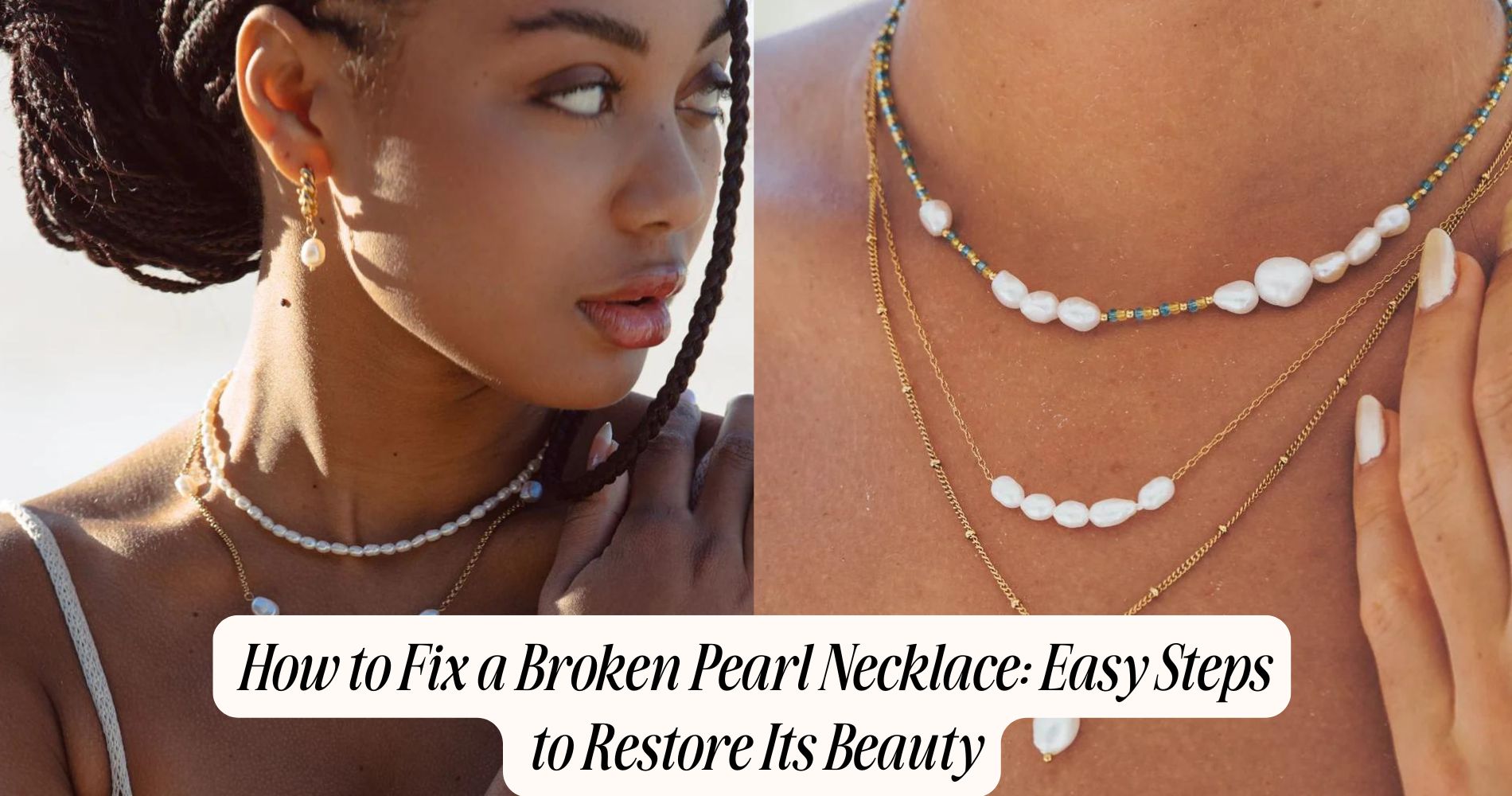
How to Untangle Jewelry: Step-by-Step Guide
Wondering how to untangle jewelry without damaging your favorite pieces? Start by assessing the jewelry to identify knot types and materials, prioritizing delicate or valuable items. Gather essential tools like fine-tipped tweezers, a needle, and a soft cloth. Begin with simple knots by gently pulling apart the ends. For more stubborn tangles, apply a small drop of olive or baby oil to loosen them. When dealing with complex tangles, lay the jewelry flat and use the 'pinch and pull' method to carefully separate links. To prevent future knots, invest in proper storage solutions. There's even more valuable advice available, particularly for maintaining waterproof necklaces.
Assess the Tangled Jewelry
Before diving into the untangling process, it's essential to evaluate the tangled jewelry thoroughly. Start by examining the pieces carefully, identifying the various tangle types present. You might encounter knots, loops, or chains intertwined with each other. Understanding the nature of the tangles will help you determine the best approach for each situation.
Next, take note of the jewelry materials involved. Different materials, such as gold, silver, or delicate beads, require specific handling techniques. For instance, gold chains may be more resilient to gentle tugging, while beaded pieces could be more fragile and need extra care. Evaluating these details allows you to prioritize which items to work on first based on their value and fragility.
As you evaluate the tangled jewelry, keep your focus on how the materials and tangle types interact. This knowledge will guide you in selecting the right methods for untangling without causing damage.
Gather Necessary Tools
To successfully untangle jewelry, you'll need a few essential tools at your disposal. First, gather a pair of fine-tipped tweezers. These will help you navigate through the delicate knots without causing damage.
Next, grab a straight pin or a needle; these tools are excellent for loosening tight tangles. Don't forget a soft cloth or a microfiber towel to provide a cushioned surface while you work.
Having a small bowl or container handy can also be beneficial for keeping separated pieces organized. As you untangle, place each piece in the bowl to avoid further tangling.
If you often deal with tangled jewelry, consider investing in specialized jewelry storage solutions, such as a hanging organizer or compartments, to minimize future mess.
Lastly, a pair of sharp scissors can be handy, but use them with caution. Only resort to cutting when absolutely necessary, as this can permanently damage your jewelry.
With these tools and some patience, you'll be well-equipped to tackle even the most challenging knots and keep your jewelry beautifully organized using effective organizing techniques.
Start With Simple Knots
How can you effectively tackle the simplest knots first? Start by identifying the simple knot types in your tangled jewelry. Simple knots often consist of just a few loops and twists that can be resolved with careful attention.
First, locate the knot's endpoint and gently pull it apart, being mindful not to apply too much pressure, which can worsen the tangle.
Once you've identified the knot, use your fingers to manipulate it. Start with the outer loops, gradually working your way inward. If you see any tight sections, ease them apart slowly to avoid damaging delicate materials. You'll find that many simple knot types can be undone by patiently teasing the threads apart.
As you work, maintain a clear focus on the knot's structure to guarantee effective knot removal. If you're struggling, don't hesitate to step back for a moment. Returning with fresh eyes can often make the process easier.
Use Lubrication Techniques
When you encounter stubborn knots in your jewelry, applying lubrication can make a significant difference.
You can use oils like olive or baby oil, which work effectively to loosen tangled chains.
Additionally, consider alternative lubricants, such as dish soap or mineral oil, depending on the materials involved.
Oil Application Methods
A few drops of oil can work wonders in untangling stubborn jewelry chains. When you're ready to use oil, consider your oil types—lighter oils like baby oil or mineral oil are ideal since they won't leave a sticky residue.
Start by placing your tangled jewelry on a clean, flat surface. Next, apply a few drops of your chosen oil directly onto the knots or tangled areas.
Now, you'll want to use gentle application techniques. With a toothpick or a soft cloth, carefully work the oil into the knots. Be patient; it might take a few moments for the oil to penetrate and loosen the tangles. As you work, use your fingers to gently pull apart the chains. If the knots are particularly stubborn, you can add a bit more oil.
Remember to keep the oil usage minimal to avoid overwhelming your jewelry. Once you've successfully untangled the pieces, wipe off any excess oil with a clean cloth to guarantee your jewelry remains looking its best.
This method not only helps untangle but also nourishes the metal, keeping it shiny and in good condition.
Alternative Lubricants Options
Finding the right lubricant can make all the difference in effectively untangling jewelry. If you prefer alternative lubricants, there are several natural solutions you can use that are both effective and eco-friendly. Household items like olive oil, coconut oil, or even a dab of petroleum jelly can work wonders for loosening knots.
While applying these lubricants, remember to use them sparingly. A little goes a long way in jewelry care. Additionally, you might consider using specialized detangling sprays, which are designed specifically for delicate materials. These sprays often provide a gentle slip that can help ease out tangles without damaging your jewelry.
Always keep safety precautions in mind, especially when dealing with cleaning agents. Avoid using harsh chemicals that might corrode or tarnish your items. Instead, opt for natural solutions that are gentle yet effective.
Whichever option you choose, make sure that you test it on a small area of your jewelry first. This way, you can confirm that it won't react negatively with the materials.
Work on More Complex Tangles
Complex tangles can be particularly frustrating, but with a systematic approach, you can often unravel them with relative ease. Start by laying the tangled jewelry flat on a clean surface, ensuring you have good lighting. Examine the knots closely to identify the most intricate sections that need attention.
Utilize advanced untangling techniques such as the 'pinch and pull' method. Gently pinch the knot with one hand while using a thin tool, like a needle or a toothpick, with the other to tease apart the strands. This allows you to separate the intertwined links without applying too much pressure, which could cause damage.
As you work through the tangle, keep your movements slow and deliberate. If you encounter a particularly stubborn knot, don't hesitate to apply a drop of lubricant to soften it. This can make the strands glide more easily against each other.
Prevent Future Tangles
To keep your jewelry tangle-free, implementing a few simple yet effective storage solutions can make a considerable difference. Start by investing in dedicated jewelry storage options, like a jewelry box with compartments, where each piece has its own designated space. This guarantees that necklaces, bracelets, and earrings don't rub against each other, which is essential for tangle prevention.
For necklaces, consider using a stand or hooks to hang them individually. This allows gravity to work in your favor, keeping them from intertwining. You can also use small pouches or zip-lock bags for delicate pieces, protecting them from scratches and tangles alike.
When storing bracelets, try using a soft-lined tray or even a rolled-up cloth. This minimizes movement and friction, which can lead to tangles over time.
Lastly, regularly assess your jewelry collection. If you notice any pieces that frequently tangle, think about reorganizing them or even eliminating those that don't serve you.
Frequently Asked Questions
Can I Use a Hairdryer to Untangle Jewelry?
Using a hairdryer can help loosen knots in delicate jewelry materials, but be cautious. Higher heat might damage certain pieces. Instead, try low heat settings and keep a close eye on your jewelry's condition.
What Types of Jewelry Are Most Prone to Tangling?
Necklace types like chains and delicate strands often tangle easily, while bracelet styles with numerous links or charms can also create knots. Keeping them organized and stored properly can help prevent these frustrating tangles.
Is There a Specific Order for Untangling Different Pieces?
When untangling jewelry, start with delicate chains, then move to thicker pieces. Prioritize organization and use prevention tips, like storing items separately, to minimize future tangling. Patience will help you achieve a neat collection.
How Can I Clean Jewelry While Untangling It?
As you untangle your jewelry, use appropriate cleaning methods for different jewelry materials. For metal, a gentle soap solution works well, while delicate stones may require a soft cloth to avoid damage during the process.
What Should I Do if I Break a Chain While Untangling?
If you break a chain while untangling, assess the damage carefully. Consider a professional chain repair or use a small jump ring. For future safety, invest in proper jewelry storage to prevent further tangles and breakage.
Conclusion
By following these steps to untangle your jewelry, you'll not only restore your favorite pieces but also gain valuable skills for future encounters with knots. Remember to stay patient and take your time, as rushing can lead to frustration or damage. With practice, you'll become adept at tackling even the most complex tangles. Plus, implementing preventive measures will help keep your collection in pristine condition. Enjoy wearing your beautifully untangled jewelry with confidence!

























Leave a comment
This site is protected by hCaptcha and the hCaptcha Privacy Policy and Terms of Service apply.